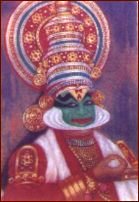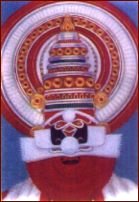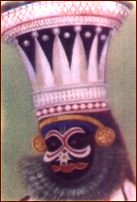Kathakali
- Costume & Make-up
From "A Dancer on Dance" written by V.P. Dhananjayan, published by Bharata Kalanjali
The costumes are very elaborate
and fall into basic types. The make up is equally elaborate.
While being made up, the actors lie on their backs as the make up men work
on their faces. The facial makeup is designed in such a way as to
indicate the intrinsic nature of each and every character. Pacha,
Kathi, Thadi, Kari, Minukku and Theppu are the different types of make-up
followed in Kathakali which are determined according to the basic qualities
of the character portrayed. The underlying purpose is to create in
the minds of the audience an atmosphere of the supernatural.
As all the stories depicted in Kathakali
relate to mythological characters and as the natural stage is nothing more
than a few square feet, lit by a single coconut oil fed lap, the entire
get up is designed to generate an atmosphere to suit the story. The
loud instrument used, the make-up and costumes employed, the painting of
the faces, the display of the 'Chutti' as part of the facial make-up, are
only the instruments used to achieve this objective. Irrespective
of the individual who puts on the costume of a character like Nala, the
audiences sees only Nala. The individual artiste is fully submerged
by the elaborate make-up. It is, however, true that the outstanding
talents of an individual artiste cannot be contained within the formal
frame-work of a standard costume. In course of time, the individual
does make an impression on the audience, but on a basis quite different
from other histrionic arts. The costumes are thus intended to make
the play as impersonal as possible.
 Pacha
Pacha
Mythological characters are classified
into different categories. The first in the order of precedence is
the Dhirodatta, the noble hearted, upright hero. The make-up known
as Pacha (Green) is allotted to such characters. Examples are the
Gods of the elements, noble kings like Nala, Yudhishtra, Rukmangada, Arjuna
and Bhimsena. Even Daksha is given Pacha, although he ultimately
turns out to be arrogant and wayward. All characters who do Pacha
also wear Kiritas (Headgear). But when it comes to characters like
Vishnu, Krishna or Rama (the incarnation) head gear is changed to what
is called Mudi. This costume also has now come to be referred to
as 'Mudi'. For both Mudi and Pacha, the facial make-up is the same.
krishna wears a dark jacket as distinct from the purple or red jackets
of Pacha.
 Kathi
Kathi
Kathi, another prominent costume
of kathakali is devoted to heroes who are not too particular about the
means they use to gain their needs. The costume in general is similar
to Pacha, except that in the make-up, a knife-shaped pattern is drawn on
either cheek in red pigment. In addition, a small ball is fixed to
the tip of the nose and another one in the fore-head. kathi represents
restlessness easily swayed towards wickedness and is the costume of characters
like Ravana, Kamsa and Duryodhana. Kathi can be said to denote a
combination of royalty and evil. Kings of demons like Ravana, or
demons among kings and villains are depicted in Kathi. Whereas 'Pacha'
characters do not open their mouths or create any noise 'Kathi' characters
are permitted to make weird noises appropriate to the occasion or to the
emotion expressed.
 Thadi
(Beard)
Thadi
(Beard)
The costume that represents Thamoguna
(wickedness) is Thadi. Thadi means beard. There are red, black
and white thadis, each depicting a distinct type of wickedness. Red
thadi has the face painted in frightening dark portions and wears an impressive
red beard. The head gear is round in shape and much larger in size
than those worn by Kathi. Red thadi is usually given to extremely
wicked characters like Rakshasas or despicable men like Dussasana.
Examples of Rakshasas are Bakasura and Jatasura. The concept of the
red thadi is only of the destructive evil force with little or no thinking
faculty. The costume has, therefore, been extended to portray roles
like Srichakra and Veerabhadra. Srichakra is the all powerful weapon
of Vishnu. Annihilation without thought is its motto. So also
Veerabhadra who is born out of the fire of Siva, the Destroyer, is nothing
but an agency for destruction and blind obedience.
A further extension of thadi is
its application to monkey kings like Vali and Sugriva. Here
again, the human contempt for the unthinking monkey has influenced this
decision. There is no doubt, a slight modification in the white make-up
pattern, but it is noticed only by careful observation.
White Thadi or white beard is
a further refinement of the Thadi group of characters. A good example
is Hanuman, the monkey God. The intricate patterns drawn on the face
with red, black and white, suggests a monkey face almost similar to the
baboons of african forests. Hanuman, the monkey God of the epic Ramayana
merit special mention. The crown is known as Vattamudi, a ceremonial
military hat-like headgear and a white beard. The make-up is different
from the ones usually given to the monkeys. Hanuman occupies a very
special place in Hindu mythology. So also in Kathakali. Hanuman
is also permitted to make weird noises appropriate to the occasion.
The black Thadi or black beard is
a costume given to a character like Kali in 'Nalacharitra'. The character
is as evil as the red Thadi but has the subtle distinction of denoting
a schemer as well. The make-up is the same as red Thadi, the beard
alone being black in colour.
 Kari
(Black)
Kari
(Black)
The 'Kari'
is an all black costume. The face is painted in black; the jackets
and skirts are blacker still. The headgear is primitive. The costume
is used for depicting the lowest of primitive human beings both men and
women. The noises they produce can almost amount to howling.
Characters portrayed in this costume are demonesses and evil beings of
the 'under world'.
Chutti
The 'Chutti' or white make-up plays
a very important role in Kathakali make-up. In the olden days, the
chutti was laid, layer after layer with a mixture of rice paste and lime.
It used to take about three to four hours to get an actor's 'Chutti' done.
Today, the base is laid with a paste and the rest made of paper.
The purpose of the 'Chutti' is to raise the contours of the face so that
the area of aesthetic expression is clearly marked out. It also helps
to draw the eyes of the audience to the actor's facial expression.
Minukku
The make-up used for gentle characters
is 'Minukku'. It consists of a mere painting of the face with yellowish
orange pigment. There is no white chutty make-up and no elaborate
clothing as in other characters. Women, sages and Brahmanas appear
in 'Minukku'. Other characters who appear in Minukku are charioteers
and messengers.
The Mask
conception in Kathakali
The Chau dance of Bihar and the
Balinese dance are mask dances, but they hardly bear any resemblance to
Kathakali, which is known for its exaggerated mime and dramatic exposition.
Still there are many who mistake the Kathakali make-up as masks.
The painted face and the white frames made on the face (chutti) certainly
give the dubious appearance of a mask, but they are not, and they are drawn
and painted on the face each day employing a different artist, who is again
specialised in this art of Kathakali make-up. The rich colours are
obtained from special indigenous stones ground in coconut oil and mixed
in the right proportions to get the right shades. The mixing of these
colours and grinding of the stones another art, which again needs sense
of proportion and precision. A wrong proportion could give a wrong
chemical reaction, which could affect even the face and eyes of the actor.
The Red
Eyes
People are
often puzzled and fascinated by the red eyes of the Kathakali performers
and they wonder how it is done. Making the eyes red has two objectives.
One is to equate the colour combination on the face; if one watches a kathakali
painted face without the eyes being red, you will realise how dead the
face looks with pale eyes. Therefore against the green or black background
for the face, the eyes must have a red base to stand out vividly.
Secondly, if
the eyes are left free while all the other parts of the face are chemically
treated, it is bound to affect the eyes with the warmth emitted by these
paints. So the eyes must also be treated to equalise the chemical
reaction. To make the eyes red, a tiny bit of a herb (chundappoo)
is laid in the lower eye lid. It is very dangerous if it goes into
the upper eye lid.
'Rasaprakarana'
or (Raavikalpam) chapter in Natyasastra enunciates the various colours
attached to various moods and sentiments. Though there is not much
in common between this approach and the pattern followed in Kathakali,
it has a definite bearing on the colour schemes ascribed to various sentiments.